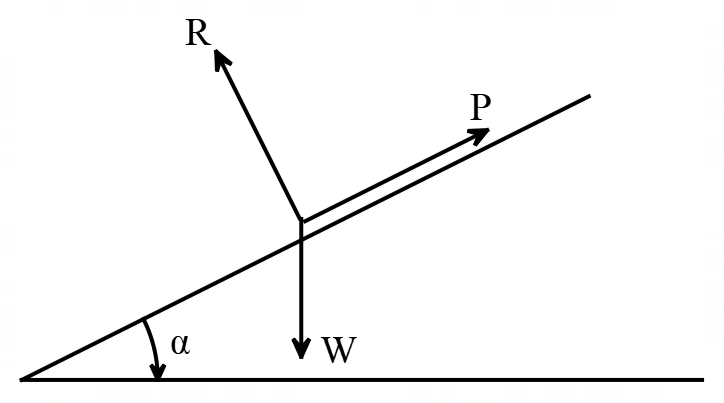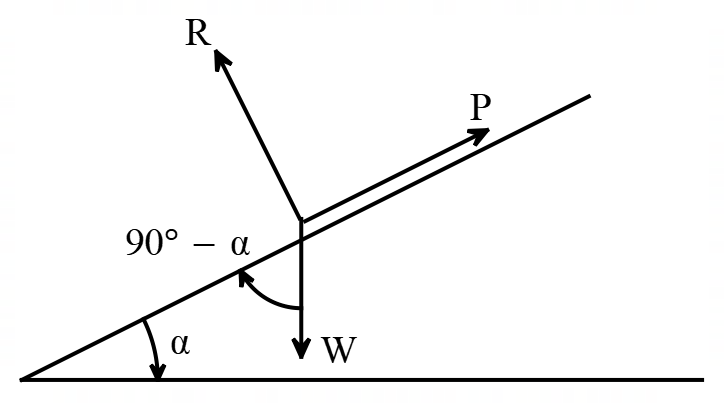শিক্ষা বোর্ড বরিশাল - 2021
উচ্চতর গণিত ( বহুনির্বাচনি )
[2021 সালের সিলেবাস অনুযায়ী ]
দ্বিতীয় পত্র বহুনির্বাচনি
বিষয় কোডঃ 266
সময়-২৫ মিনিট
পূর্ণমান-২৫
[ দ্রষ্টব্যঃ সরবরাহকৃত বহুনির্বাচনি অভীক্ষার উত্তরপত্রে প্রশ্নের ক্রমিক নম্বরের বিপরীতে প্রদত্ত বর্ণসংবলিত বৃত্তসমুহ হতে সিঠিক/সর্বোৎকৃষ্ট উত্তরের বৃত্তটি বল পয়ন্ট কলম দ্বারা সম্পুর্ণ ভরাট কর। প্রতিটি প্রশ্নের মাণ ১। প্রশ্নপত্রে কোন প্রকার দাগ/ চিহ্ন দেওয়া যাবে না। ]
উচ্চতর গণিত ( বহুনির্বাচনি )
[2021 সালের সিলেবাস অনুযায়ী ]
দ্বিতীয় পত্র বহুনির্বাচনি
বিষয় কোডঃ 266
সময়-২৫ মিনিট
পূর্ণমান-২৫
[ দ্রষ্টব্যঃ সরবরাহকৃত বহুনির্বাচনি অভীক্ষার উত্তরপত্রে প্রশ্নের ক্রমিক নম্বরের বিপরীতে প্রদত্ত বর্ণসংবলিত বৃত্তসমুহ হতে সিঠিক/সর্বোৎকৃষ্ট উত্তরের বৃত্তটি বল পয়ন্ট কলম দ্বারা সম্পুর্ণ ভরাট কর। প্রতিটি প্রশ্নের মাণ ১। প্রশ্নপত্রে কোন প্রকার দাগ/ চিহ্ন দেওয়া যাবে না। ]
১। \(x^2-4x+3=0\) সমীকরণের মূলদ্বয় \(\alpha\) এবং \(\beta\) হয় তবে \(\frac{1}{\alpha}+\frac{1}{\beta}\) এর মান-
\(\Rightarrow \alpha+\beta=-\frac{-4}{1}, \ \alpha\beta=\frac{3}{1}\)
\(\therefore \alpha+\beta=4, \ \alpha\beta=3\)
এখন, \(\frac{1}{\alpha}+\frac{1}{\beta}\)
\(=\frac{\alpha+\beta}{\alpha\beta}\)
\(=\frac{4}{3}\)
উত্তর ঃ (ক)
ক \(\frac{4}{3}\)
গ \(-\frac{4}{3}\)
গ \(-\frac{4}{3}\)
খ \(\frac{3}{4}\)
ঘ \(-\frac{3}{4}\)
\(x^2-4x+3=0\) সমীকরণের মূলদ্বয় \(\alpha\) এবং \(\beta\)ঘ \(-\frac{3}{4}\)
\(\Rightarrow \alpha+\beta=-\frac{-4}{1}, \ \alpha\beta=\frac{3}{1}\)
\(\therefore \alpha+\beta=4, \ \alpha\beta=3\)
এখন, \(\frac{1}{\alpha}+\frac{1}{\beta}\)
\(=\frac{\alpha+\beta}{\alpha\beta}\)
\(=\frac{4}{3}\)
উত্তর ঃ (ক)
২। \(2+i\) মূলবিশিষ্ট দ্বিঘাত সমীকরণ কোনটি?
উক্ত মূলবিশিষ্ট দ্বিঘাত সমীকরণ \(x^2-(2+i+2-i)x+(2+i)(2-i)=0\)
\(\Rightarrow x^2-4x+(2^2-i^2)=0\)
\(\Rightarrow x^2-4x+(4+1)=0\) যেহেতু \(i^2=-1\)
\(\therefore x^2-4x+5=0\)
উত্তর ঃ (ক)
ক \(x^2-4x+5=0\)
গ \(x^2-4x+3=0\)
গ \(x^2-4x+3=0\)
খ \(x^2+4x-3=0\)
ঘ \(x^2+4x-5=0\)
দ্বিঘাত সমীকরণের একটি মূল \(2+i\) হলে অপর মূলটি হয় \(2-i\)ঘ \(x^2+4x-5=0\)
উক্ত মূলবিশিষ্ট দ্বিঘাত সমীকরণ \(x^2-(2+i+2-i)x+(2+i)(2-i)=0\)
\(\Rightarrow x^2-4x+(2^2-i^2)=0\)
\(\Rightarrow x^2-4x+(4+1)=0\) যেহেতু \(i^2=-1\)
\(\therefore x^2-4x+5=0\)
উত্তর ঃ (ক)
৩। \(x^3-2x+4=0\) এর মূলগুলো \(p, \ q, \ r\) হলে, \(pqr\) এর মান-
\(\Rightarrow p+q+r=-\frac{0}{1}, \ pq+qr+pr=\frac{-2}{1}, \ pqr=-\frac{4}{1}\)
\(\therefore pqr=-4\)
উত্তর ঃ (খ)
ক \(-2\)
গ \(2\)
গ \(2\)
খ \(-4\)
ঘ \(4\)
\(x^3-2x+4=0 \Rightarrow x^3+0.x^2-2x+4=0\) এর মূলগুলো \(p, \ q, \ r\)ঘ \(4\)
\(\Rightarrow p+q+r=-\frac{0}{1}, \ pq+qr+pr=\frac{-2}{1}, \ pqr=-\frac{4}{1}\)
\(\therefore pqr=-4\)
উত্তর ঃ (খ)
৪। \(x^2+x+1=0\) সমীকরণের মূলদ্বয়ের প্রকৃতি নিম্নের কোনটি?
এখানে, \(a=1, \ b=1, \ c=1\)
নিশ্চায়ক \(D=b^2-4ac\)
\(=1^2-4.1.1\)
\(=1-4\)
\(=-3\lt{0}\)
\(\therefore D\lt{0}\)
\(\therefore\) সমীকরণের মূলদ্বয় অবাস্তব।
উত্তর ঃ (খ)
ক বাস্তব ও অসমান
গ অমূলদ
গ অমূলদ
খ অবাস্তব
ঘ বাস্তব ও সমান
\(x^2+x+1=0\)ঘ বাস্তব ও সমান
এখানে, \(a=1, \ b=1, \ c=1\)
নিশ্চায়ক \(D=b^2-4ac\)
\(=1^2-4.1.1\)
\(=1-4\)
\(=-3\lt{0}\)
\(\therefore D\lt{0}\)
\(\therefore\) সমীকরণের মূলদ্বয় অবাস্তব।
উত্তর ঃ (খ)
নিচের তথ্যের আলোকে ৫ ও ৬ নং প্রশ্নের উত্তর দাওঃ
\(x^2+2x-p=0\) একটি দ্বিঘাত সমীকরণ।
৫। সমীকরণের মূলদ্বয়ের গুণফল \(4\) হলে, \(p\) এর মান কত?\(x^2+2x-p=0\) একটি দ্বিঘাত সমীকরণ।
ক \(4\)
গ \(-4\)
গ \(-4\)
খ \(2\)
ঘ \(-2\)
ধরি, \(x^2+2x-p=0\) সমীকরণের মূলগুলো \(\alpha, \ \beta\)ঘ \(-2\)
\(\Rightarrow \alpha+\beta=-\frac{2}{1}, \ \alpha\beta=\frac{-p}{1}\)
\(\Rightarrow \alpha\beta=-p\)
\(\Rightarrow -p=4\)
\(\therefore p=-4\)
উত্তর ঃ (গ)
৬। সমীকরণের একটি মূল অপরটির দ্বিগুণ হলে মূলদ্বয় কত?
\(\Rightarrow \alpha+2\alpha=-\frac{2}{1}, \ \alpha\times2\alpha=\frac{4}{1}\)
\(\Rightarrow 3\alpha=-2\)
\(\therefore \alpha=-\frac{2}{3}\)
মূলদ্বয় \(\alpha, \ 2\alpha\)
\(=-\frac{2}{3}, \ 2\times-\frac{2}{3}\)
\(=-\frac{2}{3}, \ -\frac{4}{3}\)
উত্তর ঃ (খ)
ক \(-\frac{2}{3}, \ \frac{4}{3}\)
গ \(-\frac{4}{3}, \ \frac{2}{3}\)
গ \(-\frac{4}{3}, \ \frac{2}{3}\)
খ \(-\frac{2}{3}, \ -\frac{4}{3}\)
ঘ \(\frac{2}{3}, \ \frac{4}{3}\)
শর্তমতে, \(x^2+2x+4=0\) সমীকরণের মূলগুলো \(\alpha, \ 2\alpha\)ঘ \(\frac{2}{3}, \ \frac{4}{3}\)
\(\Rightarrow \alpha+2\alpha=-\frac{2}{1}, \ \alpha\times2\alpha=\frac{4}{1}\)
\(\Rightarrow 3\alpha=-2\)
\(\therefore \alpha=-\frac{2}{3}\)
মূলদ্বয় \(\alpha, \ 2\alpha\)
\(=-\frac{2}{3}, \ 2\times-\frac{2}{3}\)
\(=-\frac{2}{3}, \ -\frac{4}{3}\)
উত্তর ঃ (খ)
৭। \(\sec^2{(\tan^{-1}{2})}-cosec^{2}{(\cot^{-1}{3})}\) এর মান কত?
\(=1+\tan^2{(\tan^{-1}{2})}-\{1+\cot^{2}{(\cot^{-1}{3})}\}\)
\(=1+\tan^2{(\tan^{-1}{2})}-1-\cot^{2}{(\cot^{-1}{3})}\)
\(=\{\tan{(\tan^{-1}{2})}\}^2-\{\cot{(\cot^{-1}{3})}\}^{2}\)
\(=\{2\}^2-\{3\}^{2}\)
\(=4-9\)
\(=-5\)
উত্তর ঃ (ঘ)
ক \(5\)
গ \(\sqrt{5}-\sqrt{10}\)
গ \(\sqrt{5}-\sqrt{10}\)
খ \(15\)
ঘ \(-5\)
\(\sec^2{(\tan^{-1}{2})}-cosec^{2}{(\cot^{-1}{3})}\)ঘ \(-5\)
\(=1+\tan^2{(\tan^{-1}{2})}-\{1+\cot^{2}{(\cot^{-1}{3})}\}\)
\(=1+\tan^2{(\tan^{-1}{2})}-1-\cot^{2}{(\cot^{-1}{3})}\)
\(=\{\tan{(\tan^{-1}{2})}\}^2-\{\cot{(\cot^{-1}{3})}\}^{2}\)
\(=\{2\}^2-\{3\}^{2}\)
\(=4-9\)
\(=-5\)
উত্তর ঃ (ঘ)
৮। \(2\sin{\frac{\theta}{2}}-1=0\) এর সাধারণ সমাধান কোনটি?
\(\Rightarrow 2\sin{\frac{\theta}{2}}=1\)
\(\Rightarrow \sin{\frac{\theta}{2}}=\frac{1}{2}\)
\(\Rightarrow \sin{\frac{\theta}{2}}=\sin{\frac{\pi}{6}}\)
\(\Rightarrow \frac{\theta}{2}=n\pi+(-1)^n\frac{\pi}{6}\)
\(\therefore \theta=2n\pi+(-1)^n\frac{\pi}{3}\)
উত্তর ঃ (ঘ)
ক \(2n\pi-\frac{\pi}{3}\)
গ \(n\pi+(-1)^n\frac{\pi}{6}\)
গ \(n\pi+(-1)^n\frac{\pi}{6}\)
খ \(2n\pi+\frac{\pi}{3}\)
ঘ \(2n\pi+(-1)^n\frac{\pi}{3}\)
\(2\sin{\frac{\theta}{2}}-1=0\)ঘ \(2n\pi+(-1)^n\frac{\pi}{3}\)
\(\Rightarrow 2\sin{\frac{\theta}{2}}=1\)
\(\Rightarrow \sin{\frac{\theta}{2}}=\frac{1}{2}\)
\(\Rightarrow \sin{\frac{\theta}{2}}=\sin{\frac{\pi}{6}}\)
\(\Rightarrow \frac{\theta}{2}=n\pi+(-1)^n\frac{\pi}{6}\)
\(\therefore \theta=2n\pi+(-1)^n\frac{\pi}{3}\)
উত্তর ঃ (ঘ)
৯। \(f(x)=\sin^{-1}{x}\) হলে-
\(i.\) \(f(x)+f(\sqrt{1-x^2})=\frac{\pi}{2}\)
\(ii.\) \(cosec{\{f(x)\}}=\frac{1}{x}\)
\(iii.\) \(f(1)=\frac{\pi}{2}\)
নিচের কোনটি সঠিক?
\(f(x)+f(\sqrt{1-x^2})\)
\(=\sin^{-1}{x}+\sin^{-1}{(1-x^2)}\)
\(=\sin^{-1}{x}+\cos^{-1}{x}\)
\(=\frac{\pi}{2}\)
\(\therefore f(x)+f(\sqrt{1-x^2})=\frac{\pi}{2}\)
\(\therefore i.\) বাক্যটি সত্য।
\(f(x)=\sin^{-1}{x}\) হলে,
\(cosec{\{f(x)\}}\)
\(=cosec{\{\sin^{-1}{x}\}}\)
\(=\frac{1}{\sin{\{\sin^{-1}{x}\}}}\)
\(=\frac{1}{x}\)
\(\therefore cosec{\{f(x)\}}=\frac{1}{x}\)
\(\therefore ii.\) বাক্যটি সত্য।
\(f(x)=\sin^{-1}{x}\) হলে,
\(\Rightarrow f(1)=\sin^{-1}{1}\)
\(\therefore f(1)=\frac{\pi}{2}\)
\(\therefore iii.\) বাক্যটি সত্য।
উত্তর ঃ (ঘ)
\(i.\) \(f(x)+f(\sqrt{1-x^2})=\frac{\pi}{2}\)
\(ii.\) \(cosec{\{f(x)\}}=\frac{1}{x}\)
\(iii.\) \(f(1)=\frac{\pi}{2}\)
নিচের কোনটি সঠিক?
ক \(i.\) ও \(ii.\)
গ \(ii.\) ও \(iii.\)
গ \(ii.\) ও \(iii.\)
খ \(i.\) ও \(iii.\)
ঘ \(i.\), \(ii.\) ও \(iii.\)
\(f(x)=\sin^{-1}{x}\) হলে,ঘ \(i.\), \(ii.\) ও \(iii.\)
\(f(x)+f(\sqrt{1-x^2})\)
\(=\sin^{-1}{x}+\sin^{-1}{(1-x^2)}\)
\(=\sin^{-1}{x}+\cos^{-1}{x}\)
\(=\frac{\pi}{2}\)
\(\therefore f(x)+f(\sqrt{1-x^2})=\frac{\pi}{2}\)
\(\therefore i.\) বাক্যটি সত্য।
\(f(x)=\sin^{-1}{x}\) হলে,
\(cosec{\{f(x)\}}\)
\(=cosec{\{\sin^{-1}{x}\}}\)
\(=\frac{1}{\sin{\{\sin^{-1}{x}\}}}\)
\(=\frac{1}{x}\)
\(\therefore cosec{\{f(x)\}}=\frac{1}{x}\)
\(\therefore ii.\) বাক্যটি সত্য।
\(f(x)=\sin^{-1}{x}\) হলে,
\(\Rightarrow f(1)=\sin^{-1}{1}\)
\(\therefore f(1)=\frac{\pi}{2}\)
\(\therefore iii.\) বাক্যটি সত্য।
উত্তর ঃ (ঘ)
১০। \(\cos{\theta}+\sqrt{3}\sin{\theta}=2\) এর সাধারণ সমাধান কোনটি?
\(\Rightarrow \cos{\theta}+\sqrt{3}\sin{\theta}=2\)
\(\Rightarrow \cos{\theta}\frac{1}{2}+\frac{\sqrt{3}}{2}\sin{\theta}=\frac{2}{2}\) উভয় পার্শ্বে \(\sqrt{1^2+(\sqrt{3})^2}=\sqrt{1+3}=2\) ভাগ করে।
\(\Rightarrow \cos{\theta}\cos{\frac{\pi}{3}}+\sin{\frac{\pi}{3}}\sin{\theta}=1\)
\(\Rightarrow \cos{\left(\theta-\frac{\pi}{3}\right)}=1\)
\(\Rightarrow \theta-\frac{\pi}{3}=2n\pi\)
\(\therefore \theta=2n\pi+\frac{\pi}{3}\)
উত্তর ঃ (খ)
ক \(2n\pi-\frac{\pi}{3}\)
গ \(2n\pi+\frac{\pi}{6}\)
গ \(2n\pi+\frac{\pi}{6}\)
খ \(2n\pi+\frac{\pi}{3}\)
ঘ \(2n\pi-\frac{\pi}{6}\)
\(\cos{\theta}+\sqrt{3}\sin{\theta}=2\)ঘ \(2n\pi-\frac{\pi}{6}\)
\(\Rightarrow \cos{\theta}+\sqrt{3}\sin{\theta}=2\)
\(\Rightarrow \cos{\theta}\frac{1}{2}+\frac{\sqrt{3}}{2}\sin{\theta}=\frac{2}{2}\) উভয় পার্শ্বে \(\sqrt{1^2+(\sqrt{3})^2}=\sqrt{1+3}=2\) ভাগ করে।
\(\Rightarrow \cos{\theta}\cos{\frac{\pi}{3}}+\sin{\frac{\pi}{3}}\sin{\theta}=1\)
\(\Rightarrow \cos{\left(\theta-\frac{\pi}{3}\right)}=1\)
\(\Rightarrow \theta-\frac{\pi}{3}=2n\pi\)
\(\therefore \theta=2n\pi+\frac{\pi}{3}\)
উত্তর ঃ (খ)
১১। \(\cot{\theta}\cot{2\theta}=1\) সমীকরণের সমাধান-
\(\Rightarrow \frac{\sin{\theta}}{\cos{\theta}}.\frac{\sin{2\theta}}{\cos{2\theta}}=1\)
\(\Rightarrow \frac{\sin{2\theta}\sin{\theta}}{\cos{2\theta}\cos{\theta}}=1\)
\(\Rightarrow \cos{2\theta}\cos{\theta}=\sin{2\theta}\sin{\theta}\)
\(\Rightarrow \cos{2\theta}\cos{\theta}-\sin{2\theta}\sin{\theta}=0\)
\(\Rightarrow \cos{(2\theta+\theta)}=0\)
\(\Rightarrow \cos{(3\theta)}=0\)
\(\Rightarrow 3\theta=(2n+1)\frac{\pi}{2}\)
\(\therefore \theta=(2n+1)\frac{\pi}{6}\)
উত্তর ঃ (খ)
ক \(2n\pi\)
গ \(\frac{2n\pi}{3}\)
গ \(\frac{2n\pi}{3}\)
খ \((2n+1)\frac{\pi}{6}\)
ঘ \((2n-1)\frac{\pi}{6}\)
\(\cot{\theta}.\cot{2\theta}=1\)ঘ \((2n-1)\frac{\pi}{6}\)
\(\Rightarrow \frac{\sin{\theta}}{\cos{\theta}}.\frac{\sin{2\theta}}{\cos{2\theta}}=1\)
\(\Rightarrow \frac{\sin{2\theta}\sin{\theta}}{\cos{2\theta}\cos{\theta}}=1\)
\(\Rightarrow \cos{2\theta}\cos{\theta}=\sin{2\theta}\sin{\theta}\)
\(\Rightarrow \cos{2\theta}\cos{\theta}-\sin{2\theta}\sin{\theta}=0\)
\(\Rightarrow \cos{(2\theta+\theta)}=0\)
\(\Rightarrow \cos{(3\theta)}=0\)
\(\Rightarrow 3\theta=(2n+1)\frac{\pi}{2}\)
\(\therefore \theta=(2n+1)\frac{\pi}{6}\)
উত্তর ঃ (খ)
১২। \(\cot{k}=\frac{1}{2}\) হলে, \(\cot{\tan^{-1}{\sec{\sin^{-1}{\cot{k}}}}}\) এর মান কত?
\(=\cot{\tan^{-1}{\sec{\sin^{-1}{\frac{1}{2}}}}}\)
\(=\cot{\tan^{-1}{\sec{\frac{\pi}{6}}}}\)
\(=\cot{\tan^{-1}{\frac{2}{\sqrt{3}}}}\)
\(=\cot{\cot^{-1}{\frac{\sqrt{3}}{2}}}\)
\(=\frac{\sqrt{3}}{2}\)
উত্তর ঃ (গ)
ক \(\frac{1}{2}\)
গ \(\frac{\sqrt{3}}{2}\)
গ \(\frac{\sqrt{3}}{2}\)
খ \(\frac{2}{\sqrt{3}}\)
ঘ \(2\)
\(\cot{\tan^{-1}{\sec{\sin^{-1}{\cot{k}}}}}\)ঘ \(2\)
\(=\cot{\tan^{-1}{\sec{\sin^{-1}{\frac{1}{2}}}}}\)
\(=\cot{\tan^{-1}{\sec{\frac{\pi}{6}}}}\)
\(=\cot{\tan^{-1}{\frac{2}{\sqrt{3}}}}\)
\(=\cot{\cot^{-1}{\frac{\sqrt{3}}{2}}}\)
\(=\frac{\sqrt{3}}{2}\)
উত্তর ঃ (গ)
১৩। \(y^2=4x+8y\) পরাবৃত্তের শীর্ষবিন্দু-
\(\Rightarrow y^2-8y=4x\)
\(\Rightarrow y^2-8y+16=4x+16\)
\(\Rightarrow (y-4)^2=4(x+4)\)
\(\Rightarrow Y^2=4X\) যেখানে, \(X=x+4, \ Y=y-4\)
শীর্ষবিন্দুতে, \(X=0, \ Y=0\)
\(\Rightarrow x+4=0, \ y-4=0\)
\(\Rightarrow x=-4, \ y=4\)
শীর্ষবিন্দু \((-4, 4)\)
উত্তর ঃ (খ)
ক \((4, 4)\)
গ \((-4, -4)\)
গ \((-4, -4)\)
খ \((-4, 4)\)
ঘ \((4, -4)\)
\(y^2=4x+8y\)ঘ \((4, -4)\)
\(\Rightarrow y^2-8y=4x\)
\(\Rightarrow y^2-8y+16=4x+16\)
\(\Rightarrow (y-4)^2=4(x+4)\)
\(\Rightarrow Y^2=4X\) যেখানে, \(X=x+4, \ Y=y-4\)
শীর্ষবিন্দুতে, \(X=0, \ Y=0\)
\(\Rightarrow x+4=0, \ y-4=0\)
\(\Rightarrow x=-4, \ y=4\)
শীর্ষবিন্দু \((-4, 4)\)
উত্তর ঃ (খ)
১৪। \(y=3x+c\) রেখাটি \(\frac{x^2}{5}+\frac{y^2}{3}=1\) উপবৃত্তের স্পর্শক হলে \(c\) এর মান কত?
\(\therefore \frac{x^2}{(\sqrt{5})^2}+\frac{y^2}{(\sqrt{3})^2}=1\)
এখানে, \(m=3, \ a=\sqrt{5}, \ b=\sqrt{3}\)
\(y=3x+c\) রেখাটি \(\frac{x^2}{5}+\frac{y^2}{3}=1\) উপবৃত্তের স্পর্শক হওয়ার শর্ত,
\(c=\pm\sqrt{(a^2m^2+b^2)}\)
\(=\pm\sqrt{(5\times9+3)}\)
\(=\pm\sqrt{(45+3)}\)
\(=\pm\sqrt{(48)}\)
\(=\pm4\sqrt{3}\)
উত্তর ঃ (ঘ)
ক \(\pm2\sqrt{7}\)
গ \(\pm6\sqrt{6}\)
গ \(\pm6\sqrt{6}\)
খ \(\pm3\sqrt{26}\)
ঘ \(\pm4\sqrt{3}\)
\(y=3x+c\) রেখাটি \(\frac{x^2}{5}+\frac{y^2}{3}=1\) উপবৃত্তের স্পর্শকঘ \(\pm4\sqrt{3}\)
\(\therefore \frac{x^2}{(\sqrt{5})^2}+\frac{y^2}{(\sqrt{3})^2}=1\)
এখানে, \(m=3, \ a=\sqrt{5}, \ b=\sqrt{3}\)
\(y=3x+c\) রেখাটি \(\frac{x^2}{5}+\frac{y^2}{3}=1\) উপবৃত্তের স্পর্শক হওয়ার শর্ত,
\(c=\pm\sqrt{(a^2m^2+b^2)}\)
\(=\pm\sqrt{(5\times9+3)}\)
\(=\pm\sqrt{(45+3)}\)
\(=\pm\sqrt{(48)}\)
\(=\pm4\sqrt{3}\)
উত্তর ঃ (ঘ)
১৫। \(\frac{x^2}{16}-\frac{y^2}{9}=1\) অধিবৃত্তের (hyperbola) অনুবন্ধী অক্ষের দৈর্ঘ্য কত?
\(\therefore \frac{x^2}{4^2}-\frac{y^2}{3^2}=1\)
এখানে, \(a=4, \ b=3\)
অনুবন্ধী অক্ষের দৈর্ঘ্য \(=|2b|\)
\(=|2\times3|\)
\(=|6|\)
\(=6\)
উত্তর ঃ (গ)
ক \(4\)
গ \(6\)
গ \(6\)
খ \(5\)
ঘ \(8\)
\(\frac{x^2}{16}-\frac{y^2}{9}=1\)ঘ \(8\)
\(\therefore \frac{x^2}{4^2}-\frac{y^2}{3^2}=1\)
এখানে, \(a=4, \ b=3\)
অনুবন্ধী অক্ষের দৈর্ঘ্য \(=|2b|\)
\(=|2\times3|\)
\(=|6|\)
\(=6\)
উত্তর ঃ (গ)
১৬। \(x^2+2y=0\) সমীকরণের লেখচিত্র কোনটি?
\(\Rightarrow x^2=-2y\)
\(x\) এর সকল বাস্তব মানের \(y\) এর মান ঋণাত্মক।
\(\therefore \) লেখচিত্রটি \(x\) অক্ষের নিচে অবস্থিত।
যা 'গ' অপশনকে নির্দেশ করে।
উত্তরঃ ( গ )
ক 
গ

গ

খ 
ঘ
\(x^2+2y=0\)
ঘ

\(\Rightarrow x^2=-2y\)
\(x\) এর সকল বাস্তব মানের \(y\) এর মান ঋণাত্মক।
\(\therefore \) লেখচিত্রটি \(x\) অক্ষের নিচে অবস্থিত।
যা 'গ' অপশনকে নির্দেশ করে।
উত্তরঃ ( গ )
১৭। \(4y^2-9x^2=36\) অধিবৃত্তের শীর্ষবিন্দু কত?
\(\Rightarrow \frac{4y^2}{36}-\frac{9x^2}{36}=1\)
\(\Rightarrow \frac{y^2}{9}-\frac{x^2}{4}=1\)
\(\therefore \frac{y^2}{3^2}-\frac{x^2}{2^2}=1\)
এখানে, \(a=2, \ b=3\)
অধিবৃত্তের শীর্ষবিন্দু, \((0, \pm{b})\)
\(\therefore (0, \pm3)\)
উত্তর ঃ (খ)
ক \((\pm3, 0)\)
গ \((\pm2, 0)\)
গ \((\pm2, 0)\)
খ \((0, \pm3)\)
ঘ \((0, \pm2)\)
\(4y^2-9x^2=36\)ঘ \((0, \pm2)\)
\(\Rightarrow \frac{4y^2}{36}-\frac{9x^2}{36}=1\)
\(\Rightarrow \frac{y^2}{9}-\frac{x^2}{4}=1\)
\(\therefore \frac{y^2}{3^2}-\frac{x^2}{2^2}=1\)
এখানে, \(a=2, \ b=3\)
অধিবৃত্তের শীর্ষবিন্দু, \((0, \pm{b})\)
\(\therefore (0, \pm3)\)
উত্তর ঃ (খ)
১৮। \(9x^2+4y^2=36\) উপবৃত্তের-
\(i.\) উৎকেন্দ্রিকতা \(\frac{\sqrt{5}}{3}\)
\(ii.\) উপকেন্দ্রের স্থানাংক \((0, \pm\sqrt{5})\)
\(iii.\) বৃহৎ অক্ষের দৈর্ঘ্য \(=6\)
নিচের কোনটি সঠিক?
\(\Rightarrow \frac{9x^2}{36}+\frac{4y^2}{36}=1\)
\(\Rightarrow \frac{x^2}{4}+\frac{y^2}{9}=1\)
\(\therefore \frac{x^2}{2^2}+\frac{y^2}{3^2}=1\)
এখানে, \(a=2, \ b=3, \ a\lt{b}\)
উৎকেন্দ্রিকতা \(=\sqrt{1-\frac{a^2}{b^2}}\)
\(=\sqrt{1-\frac{4}{9}}\)
\(=\sqrt{\frac{9-4}{9}}\)
\(=\sqrt{\frac{5}{9}}\)
\(=\frac{\sqrt{5}}{3}\)
\(\therefore i.\) বাক্যটি সত্য।
উপকেন্দ্রের স্থানাংক \((0, \pm{be})\)
\(\Rightarrow \left(0, \pm{3\times\frac{\sqrt{5}}{3}}\right)\)
\(\Rightarrow (0, \pm\sqrt{5})\)
\(\therefore ii.\) বাক্যটি সত্য।
বৃহৎ অক্ষের দৈর্ঘ্য \(=|2b|\)
\(=|2\times3|\)
\(=6\)
\(\therefore iii.\) বাক্যটি সত্য।
উত্তর ঃ (ঘ)
\(i.\) উৎকেন্দ্রিকতা \(\frac{\sqrt{5}}{3}\)
\(ii.\) উপকেন্দ্রের স্থানাংক \((0, \pm\sqrt{5})\)
\(iii.\) বৃহৎ অক্ষের দৈর্ঘ্য \(=6\)
নিচের কোনটি সঠিক?
ক \(i.\) ও \(ii.\)
গ \(ii.\) ও \(iii.\)
গ \(ii.\) ও \(iii.\)
খ \(i.\) ও \(iii.\)
ঘ \(i.\), \(ii.\) ও \(iii.\)
\(9x^2+4y^2=36\)ঘ \(i.\), \(ii.\) ও \(iii.\)
\(\Rightarrow \frac{9x^2}{36}+\frac{4y^2}{36}=1\)
\(\Rightarrow \frac{x^2}{4}+\frac{y^2}{9}=1\)
\(\therefore \frac{x^2}{2^2}+\frac{y^2}{3^2}=1\)
এখানে, \(a=2, \ b=3, \ a\lt{b}\)
উৎকেন্দ্রিকতা \(=\sqrt{1-\frac{a^2}{b^2}}\)
\(=\sqrt{1-\frac{4}{9}}\)
\(=\sqrt{\frac{9-4}{9}}\)
\(=\sqrt{\frac{5}{9}}\)
\(=\frac{\sqrt{5}}{3}\)
\(\therefore i.\) বাক্যটি সত্য।
উপকেন্দ্রের স্থানাংক \((0, \pm{be})\)
\(\Rightarrow \left(0, \pm{3\times\frac{\sqrt{5}}{3}}\right)\)
\(\Rightarrow (0, \pm\sqrt{5})\)
\(\therefore ii.\) বাক্যটি সত্য।
বৃহৎ অক্ষের দৈর্ঘ্য \(=|2b|\)
\(=|2\times3|\)
\(=6\)
\(\therefore iii.\) বাক্যটি সত্য।
উত্তর ঃ (ঘ)
নিচের তথ্যের আলোকে ১৯ ও ২০ নং প্রশ্নের উত্তর দাওঃ
\(P\) মানের দুইটি সমান বল \(OX\) ও \(OY\) বরাবর ক্রিয়া করে। বল দুইটির মধ্যবর্তী কোণ \(90^{o}\)।
১৯। বল দুইটির লব্ধি \(OX\) এর সাথে কত কোণ উৎপন্ন করে?\(P\) মানের দুইটি সমান বল \(OX\) ও \(OY\) বরাবর ক্রিয়া করে। বল দুইটির মধ্যবর্তী কোণ \(90^{o}\)।
ক \(15^{o}\)
গ \(45^{o}\)
গ \(45^{o}\)
খ \(30^{o}\)
ঘ \(90^{o}\)
\(P\) মানের দুইটি সমান বল \(OX\) ও \(OY\) বরাবর ক্রিয়া করে। বল দুইটির মধ্যবর্তী কোণ \(90^{o}\)।ঘ \(90^{o}\)
এখানে, \(\alpha=90^{o}\)
\(OX\) এর সাথে উৎপন্ন কোণ \(=\theta\)
\(\theta=\tan^{-1}{\left(\frac{P\sin{\alpha}}{P+P\cos{\alpha}}\right)}\)
\(=\tan^{-1}{\left(\frac{P\sin{90^{o}}}{P+P\cos{90^{o}}}\right)}\)
\(=\tan^{-1}{\left(\frac{P.1}{P+P.0}\right)}\)
\(=\tan^{-1}{\left(\frac{P}{P}\right)}\)
\(=\tan^{-1}{\left(1\right)}\)
\(=\tan^{-1}{\left(\tan{45^{o}}\right)}\)
\(=45^{o}\)
উত্তর ঃ (গ)
২০। বল দুইটির লব্ধির মান কত?
লব্ধি, \(R=\sqrt{P^2+P^2+2P.P\cos{90^{o}}}\)
\(=\sqrt{2P^2+2P^2\times0}\)
\(=\sqrt{2P^2+0}\)
\(=\sqrt{2P^2}\)
\(=\sqrt{2}P\)
\(\therefore R=\sqrt{2}P\)
উত্তর ঃ (ক)
ক \(\sqrt{2}P\)
গ \(2P\)
গ \(2P\)
খ \(\sqrt{3}P\)
ঘ \(3P\)
\(P\) মানের দুইটি সমান বল \(OX\) ও \(OY\) বরাবর ক্রিয়া করে। বল দুইটির মধ্যবর্তী কোণ \(90^{o}\)।ঘ \(3P\)
লব্ধি, \(R=\sqrt{P^2+P^2+2P.P\cos{90^{o}}}\)
\(=\sqrt{2P^2+2P^2\times0}\)
\(=\sqrt{2P^2+0}\)
\(=\sqrt{2P^2}\)
\(=\sqrt{2}P\)
\(\therefore R=\sqrt{2}P\)
উত্তর ঃ (ক)
২১।
 উদ্দীপকের আলোকে \(R\) ও \(W\) এর মধ্যবর্তী কোণ কত?
উদ্দীপকের আলোকে \(R\) ও \(W\) এর মধ্যবর্তী কোণ কত?
 আবার, তল ভূমির সাথে \(\alpha\) এবং \(W\) এর ক্রিয়ারেখার সাথে \(90^{o}-\alpha\) কোণ উৎপন্ন করে।
আবার, তল ভূমির সাথে \(\alpha\) এবং \(W\) এর ক্রিয়ারেখার সাথে \(90^{o}-\alpha\) কোণ উৎপন্ন করে।
\(R\) ও \(W\) এর মধ্যবর্তী কোণ \(=90^{o}+90^{o}-\alpha\)
\(=180^{o}-\alpha\)
উত্তর ঃ (গ)
 উদ্দীপকের আলোকে \(R\) ও \(W\) এর মধ্যবর্তী কোণ কত?
উদ্দীপকের আলোকে \(R\) ও \(W\) এর মধ্যবর্তী কোণ কত?
ক \(90^{o}-\alpha\)
গ \(180^{o}-\alpha\)
গ \(180^{o}-\alpha\)
খ \(90^{o}+\alpha\)
ঘ \(180^{o}+\alpha\)
চিত্রে ইহা স্পষ্ট যে \(R\) তলের সাথে \(90^{o}\) কোণ করে।ঘ \(180^{o}+\alpha\)
 আবার, তল ভূমির সাথে \(\alpha\) এবং \(W\) এর ক্রিয়ারেখার সাথে \(90^{o}-\alpha\) কোণ উৎপন্ন করে।
আবার, তল ভূমির সাথে \(\alpha\) এবং \(W\) এর ক্রিয়ারেখার সাথে \(90^{o}-\alpha\) কোণ উৎপন্ন করে।\(R\) ও \(W\) এর মধ্যবর্তী কোণ \(=90^{o}+90^{o}-\alpha\)
\(=180^{o}-\alpha\)
উত্তর ঃ (গ)
২২। \(5\) একক দূরত্বে \(A\) ও \(B\) বিন্দুতে ক্রিয়ারত \(9\) এবং \(5\) একক মানের সমান্তরাল বলদ্বয়-
\(i.\) অসদৃশ হলে লব্ধির মান \(4\) একক
\(ii.\) সদৃশ এবং লব্ধি \(C\) বিন্দুতে ক্রিয়ারত হলে \(BC=\frac{45}{14}\) একক
\(iii.\) সদৃশ হলে লব্ধির মান \(14\) একক
নিচের কোনটি সঠিক?
অসদৃশ হলে লব্ধির মান \(=9-5\)
\(=4\) একক
\(\therefore i.\) বাক্যটি সত্য।
সদৃশ এবং লব্ধি \(C\) বিন্দুতে ক্রিয়ারত হলে,
\(9.AC=5.BC\)
\(\Rightarrow \frac{AC}{BC}=\frac{5}{9}\)
\(\Rightarrow \frac{AC+BC}{BC}=\frac{5+9}{9}\)
\(\Rightarrow \frac{AB}{BC}=\frac{14}{9}\)
\(\Rightarrow \frac{BC}{AB}=\frac{9}{14}\)
\(\Rightarrow \frac{BC}{5}=\frac{9}{14}\)
\(\Rightarrow BC=\frac{9\times5}{14}\)
\(\therefore BC=\frac{45}{14}\)
\(\therefore ii.\) বাক্যটি সত্য।
সদৃশ হলে লব্ধির মান \(=9+5\)
\(=14\) একক
\(\therefore iii.\) বাক্যটি সত্য।
উত্তর ঃ (ঘ)
\(i.\) অসদৃশ হলে লব্ধির মান \(4\) একক
\(ii.\) সদৃশ এবং লব্ধি \(C\) বিন্দুতে ক্রিয়ারত হলে \(BC=\frac{45}{14}\) একক
\(iii.\) সদৃশ হলে লব্ধির মান \(14\) একক
নিচের কোনটি সঠিক?
ক \(i.\) ও \(ii.\)
গ \(ii.\) ও \(iii.\)
গ \(ii.\) ও \(iii.\)
খ \(i.\) ও \(iii.\)
ঘ \(i.\), \(ii.\) ও \(iii.\)
\(5\) একক দূরত্বে \(A\) ও \(B\) বিন্দুতে ক্রিয়ারত \(9\) এবং \(5\) একক মানের সমান্তরাল বলদ্বয়ঘ \(i.\), \(ii.\) ও \(iii.\)
অসদৃশ হলে লব্ধির মান \(=9-5\)
\(=4\) একক
\(\therefore i.\) বাক্যটি সত্য।
সদৃশ এবং লব্ধি \(C\) বিন্দুতে ক্রিয়ারত হলে,
\(9.AC=5.BC\)
\(\Rightarrow \frac{AC}{BC}=\frac{5}{9}\)
\(\Rightarrow \frac{AC+BC}{BC}=\frac{5+9}{9}\)
\(\Rightarrow \frac{AB}{BC}=\frac{14}{9}\)
\(\Rightarrow \frac{BC}{AB}=\frac{9}{14}\)
\(\Rightarrow \frac{BC}{5}=\frac{9}{14}\)
\(\Rightarrow BC=\frac{9\times5}{14}\)
\(\therefore BC=\frac{45}{14}\)
\(\therefore ii.\) বাক্যটি সত্য।
সদৃশ হলে লব্ধির মান \(=9+5\)
\(=14\) একক
\(\therefore iii.\) বাক্যটি সত্য।
উত্তর ঃ (ঘ)
২৩। \(\triangle{ABC}\) এর কৌনিক বিন্দু \(A, \ B\) ও \(C\) বিন্দুতে \(P, \ Q\) এবং \(R\) মানের তিনটি সদৃশ সমান্তরাল বল ক্রিয়াশীল। লব্ধি ত্রিভুজের ভরকেন্দ্রগামী হলে-
\(B\) ও \(C\) বিন্দুতে ক্রিয়ারত \(Q\) এবং \(R\) মানের বলদ্বয়ের লব্ধি \(BC\) এর মধ্যবিন্দু \(D\) বিন্দুতে ক্রিয়া করবে।
 তাহলে, \(Q.BD=R.CD\)
তাহলে, \(Q.BD=R.CD\)
\(\Rightarrow Q.BD=R.BD\) যেহেতু \(BC\) এর মধ্যবিন্দু \(D\)
\(\therefore Q=R .....(1)\)
আবার, \(A\) ও \(B\) বিন্দুতে ক্রিয়ারত \(P\) এবং \(Q\) মানের বলদ্বয়ের লব্ধি \(AB\) এর মধ্যবিন্দু \(F\) বিন্দুতে ক্রিয়া করবে।
তাহলে, \(P.AF=Q.FB\)
\(\Rightarrow P.AF=Q.AF\) যেহেতু \(AB\) এর মধ্যবিন্দু \(F\)
\(\therefore P=Q .....(2)\)
\((1)\) ও \((2)\) হতে,
\(P=Q=R\)
\(\therefore P:Q:R=1:1:1\)
উত্তর ঃ (ঘ)
ক \(P:Q:R=\sin{A}:\sin{B}:\sin{C}\)
গ \(P:Q:R=\sin{2A}:\sin{2B}:\sin{2C}\)
গ \(P:Q:R=\sin{2A}:\sin{2B}:\sin{2C}\)
খ \(P:Q:R=\tan{A}:\tan{B}:\tan{C}\)
ঘ \(P:Q:R=1:1:1\)
\(\triangle{ABC}\) এর কৌনিক বিন্দু \(A, \ B\) ও \(C\) বিন্দুতে \(P, \ Q\) এবং \(R\) মানের তিনটি সদৃশ সমান্তরাল বল ক্রিয়াশীল। লব্ধি ত্রিভুজের ভরকেন্দ্রগামী হলেঘ \(P:Q:R=1:1:1\)
\(B\) ও \(C\) বিন্দুতে ক্রিয়ারত \(Q\) এবং \(R\) মানের বলদ্বয়ের লব্ধি \(BC\) এর মধ্যবিন্দু \(D\) বিন্দুতে ক্রিয়া করবে।
 তাহলে, \(Q.BD=R.CD\)
তাহলে, \(Q.BD=R.CD\)\(\Rightarrow Q.BD=R.BD\) যেহেতু \(BC\) এর মধ্যবিন্দু \(D\)
\(\therefore Q=R .....(1)\)
আবার, \(A\) ও \(B\) বিন্দুতে ক্রিয়ারত \(P\) এবং \(Q\) মানের বলদ্বয়ের লব্ধি \(AB\) এর মধ্যবিন্দু \(F\) বিন্দুতে ক্রিয়া করবে।
তাহলে, \(P.AF=Q.FB\)
\(\Rightarrow P.AF=Q.AF\) যেহেতু \(AB\) এর মধ্যবিন্দু \(F\)
\(\therefore P=Q .....(2)\)
\((1)\) ও \((2)\) হতে,
\(P=Q=R\)
\(\therefore P:Q:R=1:1:1\)
উত্তর ঃ (ঘ)
২৪। \(x^2+3y^2=3\) কণিকের নিয়ামকের সমীকরণ কোনটি?
\(\Rightarrow \frac{x^2}{3}+\frac{3y^2}{3}=1\)
\(\Rightarrow \frac{x^2}{3}+\frac{y^2}{1}=1\)
\(\therefore \frac{x^2}{(\sqrt{3})^2}+\frac{y^2}{1^2}=1\)
এখানে, \(a=\sqrt{3}, \ b=1; \ a\gt{b}\)
উৎকেন্দ্রতা, \(e=\sqrt{1-\frac{b^2}{a^2}}\)
\(=\sqrt{1-\frac{1}{3}}\)
\(=\sqrt{\frac{3-1}{3}}\)
\(=\sqrt{\frac{2}{3}}\)
\(=\frac{\sqrt{2}}{\sqrt{3}}\)
নিয়ামকের সমীকরণ, \(x=\pm\frac{a}{e}\)
\(\Rightarrow x=\pm\frac{\sqrt{3}}{\frac{\sqrt{2}}{\sqrt{3}}}\)
\(\Rightarrow x=\pm\frac{3}{\sqrt{2}}\)
\(\therefore \sqrt{2}x=\pm3\)
উত্তর ঃ (ক)
ক \(\sqrt{2}x=\pm3\)
গ \(x=\pm\sqrt{2}\)
গ \(x=\pm\sqrt{2}\)
খ \(2x=\pm3\)
ঘ \(x=\pm2\)
\(x^2+3y^2=3\)ঘ \(x=\pm2\)
\(\Rightarrow \frac{x^2}{3}+\frac{3y^2}{3}=1\)
\(\Rightarrow \frac{x^2}{3}+\frac{y^2}{1}=1\)
\(\therefore \frac{x^2}{(\sqrt{3})^2}+\frac{y^2}{1^2}=1\)
এখানে, \(a=\sqrt{3}, \ b=1; \ a\gt{b}\)
উৎকেন্দ্রতা, \(e=\sqrt{1-\frac{b^2}{a^2}}\)
\(=\sqrt{1-\frac{1}{3}}\)
\(=\sqrt{\frac{3-1}{3}}\)
\(=\sqrt{\frac{2}{3}}\)
\(=\frac{\sqrt{2}}{\sqrt{3}}\)
নিয়ামকের সমীকরণ, \(x=\pm\frac{a}{e}\)
\(\Rightarrow x=\pm\frac{\sqrt{3}}{\frac{\sqrt{2}}{\sqrt{3}}}\)
\(\Rightarrow x=\pm\frac{3}{\sqrt{2}}\)
\(\therefore \sqrt{2}x=\pm3\)
উত্তর ঃ (ক)
২৫। \(2, \ 2\) এবং \(2\sqrt{2}\) একক মানের বলত্রয় একটি বস্তুর উপর ক্রিয়া করে ভারসাম্য সৃষ্টি করে। \(2\) এবং \(2\) একক মানের বলদ্বয়ের মধ্যবর্তী কোণ কত?
শর্তমতে বলদ্বয়ের লব্ধি \(2\sqrt{2}\)
তাহলে, \(2^2+2^2+2.2.2\cos{\alpha}=(2\sqrt{2})^2\)
\(\Rightarrow 4+4+8\cos{\alpha}=8\)
\(\Rightarrow 8+8\cos{\alpha}=8\)
\(\Rightarrow 8\cos{\alpha}=8-8\)
\(\Rightarrow 8\cos{\alpha}=0\)
\(\Rightarrow \cos{\alpha}=0\)
\(\Rightarrow \cos{\alpha}=\cos{90^{o}}\)
\(\therefore \alpha=90^{o}\)
উত্তর ঃ (খ)
ক \(45^{o}\)
গ \(135^{o}\)
গ \(135^{o}\)
খ \(90^{o}\)
ঘ \(180^{o}\)
ধরি, \(2\) এবং \(2\) একক মানের বলদ্বয়ের মধ্যবর্তী কোণ \(\alpha\)ঘ \(180^{o}\)
শর্তমতে বলদ্বয়ের লব্ধি \(2\sqrt{2}\)
তাহলে, \(2^2+2^2+2.2.2\cos{\alpha}=(2\sqrt{2})^2\)
\(\Rightarrow 4+4+8\cos{\alpha}=8\)
\(\Rightarrow 8+8\cos{\alpha}=8\)
\(\Rightarrow 8\cos{\alpha}=8-8\)
\(\Rightarrow 8\cos{\alpha}=0\)
\(\Rightarrow \cos{\alpha}=0\)
\(\Rightarrow \cos{\alpha}=\cos{90^{o}}\)
\(\therefore \alpha=90^{o}\)
উত্তর ঃ (খ)
- About
- Author
-
Contact
Call me at +880-1715-651163Email: Golzarrahman1966@gmail.com
Visitors online: 000003